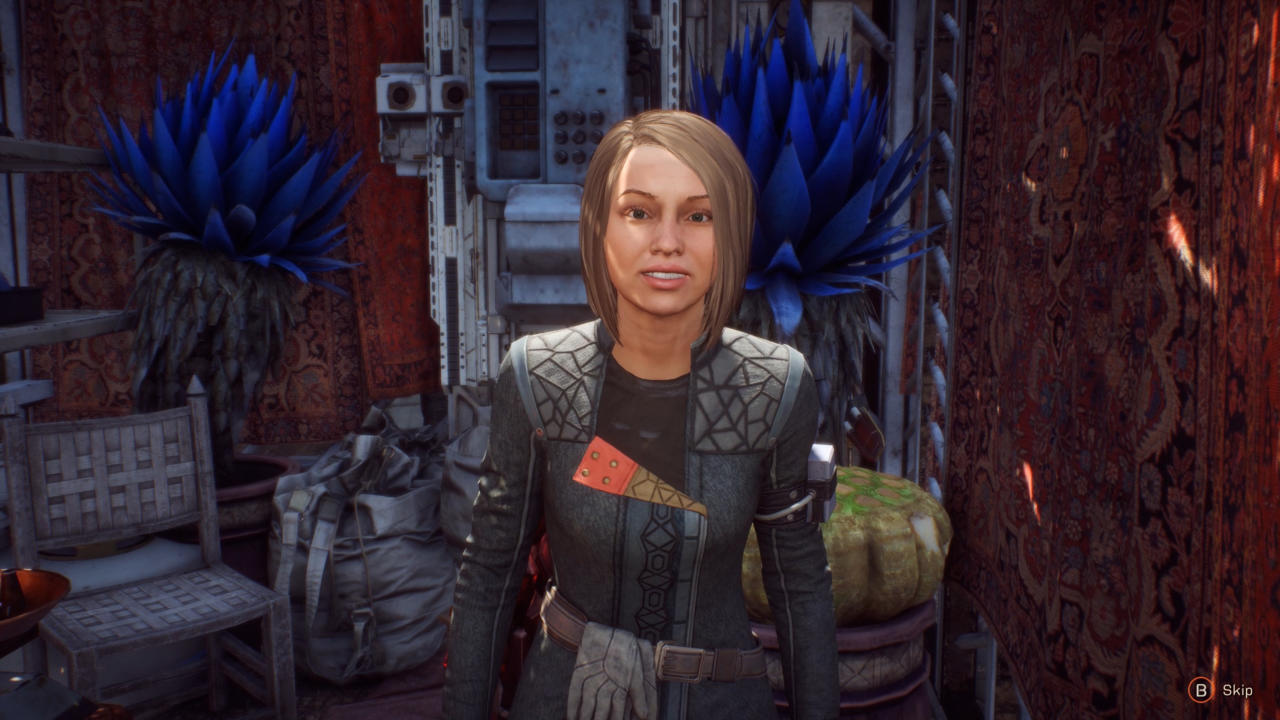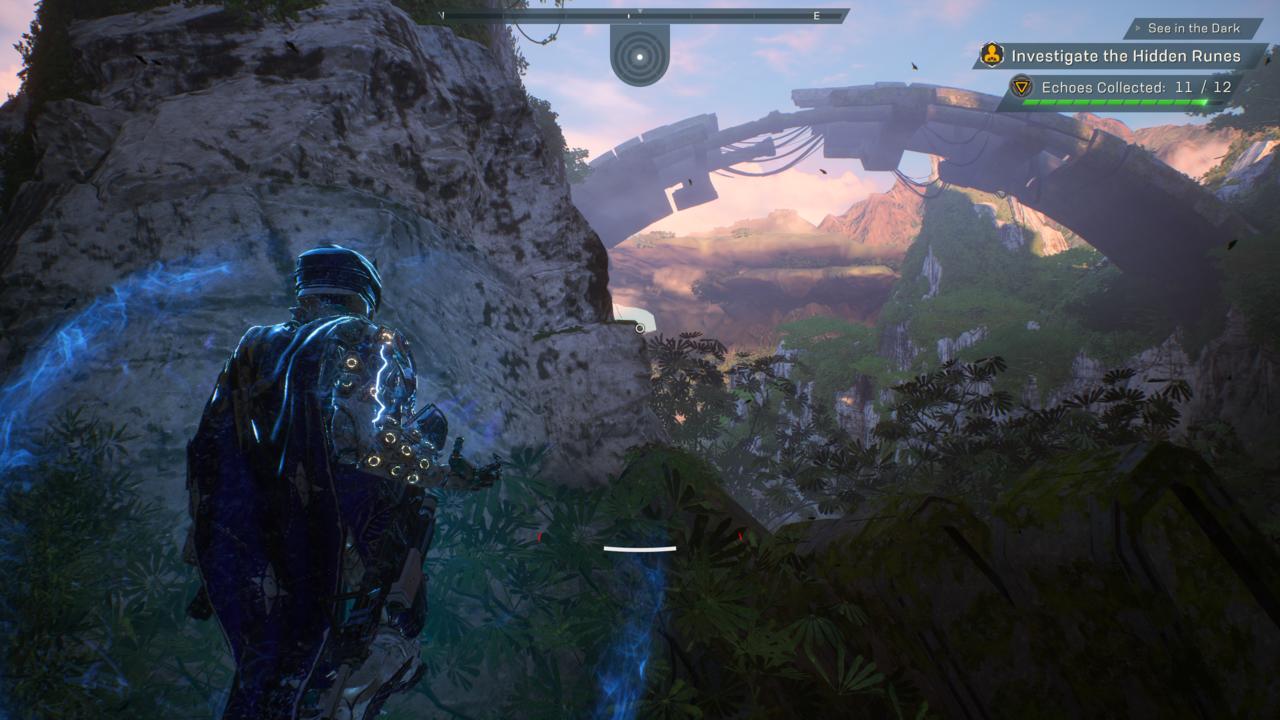Launching upward off a jungle floor and bursting through a thick canopy of trees, bobbing and weaving your way under a waterfall as you take in the lush landscape below you, is one of the highlights of Anthem. Flight, in these moments, is freeing, serene and exhilarating all at once. But you will eventually have to come back down to earth. When you don't have a means to cool down in the air, you have to interrupt your flight to cool off on the ground--or else your suit will overheat and send you careening downward much more violently. This is what Anthem is like as a whole: a game where promising moments are bookended by frustration, where good ideas are undone before they can be fully realized.
It can take a while to warm up to Anthem in the first place. In its intro mission, you are a rookie Freelancer--a hero type who battles threats to humanity in mechanized combat suits called javelins. But that brief mission ends in failure, and after a two-year time skip, you're now an experienced Freelancer. As a result, everyone talks to you as if you know everything about the world, even though much of the game's space-fantasy jargon is explained only in codex entries. "Shapers," "Arcanists," to "silence" this or that "relic"--all the dialogue is structured as if you already know what all these things are, so there's not even an element of mystery to it. It's just hard to follow.
The story and overall worldbuilding do a great disservice to the characters, which have elements of what you might think of as BioWare's pedigree. The main cast is well-acted and genuine, with complicated emotions and motivations that might have been interesting had they been given time to grow. Two characters are mad at you for the events of the tutorial, even though it's never quite clear why; that bad blood spills over into your relationship with your current partner-in-Freelancing, Owen, and there's enough believable awkwardness there to make you almost feel bad for him. But because the narrative is so poorly set up, the drama feels unearned, the "emotional" reveals robbed of their impact, and any connection you might have had to the characters just out of reach.
Exacerbating all of this is Anthem's loot game core, which is simple on paper. After every mission, you return to your base of operations, Fort Tarsis, to talk to people, get new missions, and tinker with your javelins using the loot you picked up from the previous mission. Missions themselves almost universally involve some quick narrative setup followed by flying, completing routine tasks, and plenty of combat (with more brief plot-related stuff thrown in via radio chatter).
But this general structure doesn't work well in practice. You're told up front that playing Anthem with others is the best way to play and that you'll get better rewards in a group, but this means asking your friends to be quiet every few minutes so you can hear a bit of dialogue or to wait patiently while you tweak your loadout. Playing solo is better if you want to take your time and talk to different characters, but doing so can make missions more difficult or tedious. Matchmaking with random people is the best option, since you'll have people with you for grindy parts but will leave you alone for the story--but even then, it's easy to lose track of what's going on, especially if someone in your team is ahead of you and triggering dialogue early.
And no matter what, you'll have to return to Fort Tarsis after each expedition, which makes for choppy pacing in both the story and the gameplay. There's no way to change your loadout on the go and no way to just continue on to another mission right away, and there are currently a number of loading screens in between leaving and returning to Fort Tarsis. It's hard to really get into any kind of flow.

When I finally took the time to talk to NPCs in between missions, I found endearing characters and brief but interesting bits of story spread between them. There's one girl who just loves animals no matter how dangerous, and she'll happily tell you all about them; there's the oldest man in Fort Tarsis, who admits to doing some shady things to earn that title; there's an old woman whose daughter has been missing for years and might just need some kindness. Though it took some patience to do it, I was glad I stopped to listen to them.
Throughout all of this, combat is the main thing keeping Anthem afloat. There are four types of javelins--Ranger, Storm, Interceptor, and Colossus--that are essentially a soldier, mage, assassin, and tank, respectively. Each plays differently, with a different pool of abilities, and you aren't locked into the one you start with; you unlock them as you level up. That, combined with a handful of new weapons and abilities after each mission, means that you're almost always experimenting with new loadouts and playstyles.
I initially picked the Ranger, thinking it would be a good all-around class while I was learning the basics. But the guns alone aren't enough to make Anthem combat's exciting; I found a lot of the weapons, especially shotguns, to feel ineffectual. The Ranger's abilities are pretty straightforward, too--you get grenades and missiles and the like--which left me largely unimpressed with combat in the beginning. But then I unlocked the speedy Interceptor, whose gymnastic jumps and swift melee strikes are incredibly satisfying, and I started to get excited about trying new things in each successive mission.

The Storm javelin became my favorite, though, because it both has interesting elemental abilities and can hover for minutes, not seconds, at a time before overheating. Its assortment of powers lends itself well to getting combos, which result in a satisfying explosion of sorts and a more chaotic battlefield. But more importantly, it's the only javelin that doesn't require frequent stops on the ground, and as a result it provides the most dynamic combat--you can go from shooting basic enemies in a hallway to floating above the battlefield, raining down lightning to wipe out five at once while scoping out the area for your team.
Generally, all of the javelins can easily jet out of sticky situations in a pinch or briefly hover in the air to gain the upper hand, and combining movement with your abilities is consistently a good time. But when fighting titans and certain other bosses, there's a catch; a lot of them use fire attacks that overheat your suit and ground you instantly, robbing the fight of much of what makes combat interesting. You can still use your abilities, but they don't do much in these fights, and they fall flat compared to the often bombastic impact they have on regular enemies. This extends to the final fight, which is especially underwhelming.
The endgame thus far is to complete high numbers of the various mission types, which amounts to repeating many individual missions. The draw is better gear, but without compelling high-level fights, you don't have anything to build toward with all that grinding. A post-credits cutscene has the most intriguing plot point in the game and serves as a preview of what might come later on--but right now it's just a promise, rather than a true incentive to keep going.
It's worth noting that the early access period saw a number of technical hiccups. Dropped audio, server issues, long loading times, missions not registering as complete--I didn't have a single session without some sort of problem. A day-one patch aims to iron much of this out, but overall, the poor structure and pacing are a more frustrating problem. [Editor's note: We have now tried Anthem on PS4 Pro, Xbox One, and Xbox One X. The Pro and X versions generally run decently, with some technical hiccups and occasional frame rate drops, while we encountered more stuttering and strain on the standard Xbox One.]
Anthem has good ideas, but it struggles significantly with the execution. It's a co-op game that works best with no one talking; it buries genuinely interesting character moments and puts its most incomprehensible story bits at the forefront; its combat is exciting until you get to the boss fights and find your wings have been clipped. Even the simple, exhilarating act of flying is frequently interrupted by the limitations of your javelin, and you never quite shake that feeling of disappointment--of knowing, throughout the good parts of Anthem, that you'll inevitably come crashing back down.






















